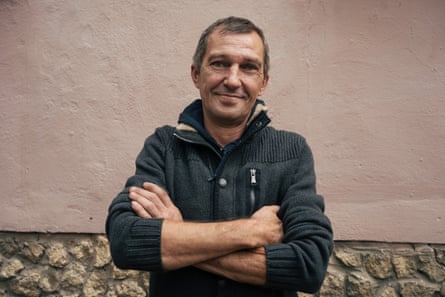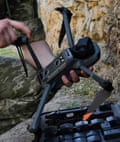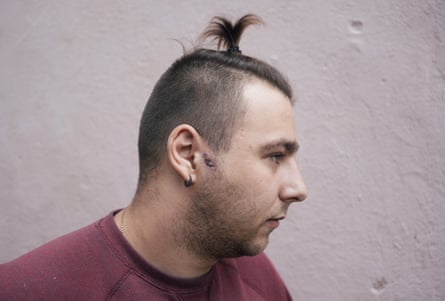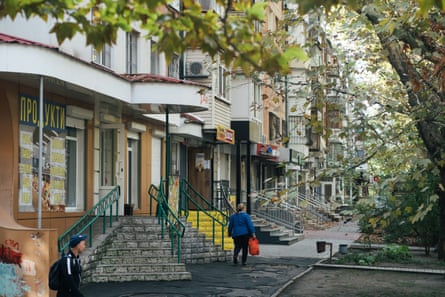Sasha Ustenko has survived three attacks by the Russian drones that stalk the streets of Kherson carrying fragmentation grenades to drop on anything that moves. The first, in late July, targeted a parked police car in central Kherson just as Ustenko walked past, throwing him to the ground. The second, in mid-August, hit a drinking water tanker as he queued for supplies, killing the driver. Ustenko was concussed, and came round to see a man lying in a pool of blood.

The third time, in late September, he heard the drone buzzing above and sprinted for shelter under the branches of a cherry tree. He hoped its leaves would hide him but the grenade tumbled through the canopy and landed barely a metre away.
The explosion ripped his left index finger apart. He is left-handed, so at 51 he is learning to write again with his other hand. When he speaks, his sentences sometimes peter out, the impact of multiple concussions, and he struggles to stand because of repeated blast injuries to his back.


Two years into Russia’s invasion of Ukraine, civilians living in the frontline city of Kherson are grappling with the new threat from small civilian drones adapted to carry explosives.
On social media, Russian soldiers openly boast that their objective is anyone or anything that moves. Since the drones began swarming the city in July, there have been thousands of attacks each month, killing 24 civilians and injuring hundreds more.
“The hunt has started,” urged one Telegram post above a satellite image of an ordinary van. “Any black minivan must be destroyed no matter where are they going.”
They have dropped grenades on buses and people waiting at bus stops, civilians on bikes and queueing for humanitarian aid, or, like Ustenko, just walking home with shopping.
One video, shared by a drone operator, follows two people ambling down a quiet Kherson street oblivious to the drone overhead until it drops a grenade that cuts both down, leaving them writhing on the ground in agony.
The repurposed Mavic drones, made in China for photography and videos, are controlled on radio frequencies that Ukraine’s anti-drone systems cannot block, and are too small, too numerous and fly too low for traditional air defences to pick up.
In August there were more than 2,500 attacks, or dozens each day, the vast majority of them inside Kherson city, said Oleksandr Tolokonnikov, a spokesperson for the Kherson military administration. In September there were more than 2,700.
Between 1 July and 11 October, drones injured more than 400 civilians, including seven children. Many of those injuries were life-changing, including some requiring amputations, Tolokonnikov said.

They are driving Kherson citizens out of areas where they had clung on through nine months of occupation after the full-scale Russian invasion of Kherson in February 2022 and another two years of war.
“There were maybe 1,500 or 2,000 people in my area after the Russian occupation ended. Now there are 1,000 at most,” said Dima Olifirenko, 22, a sailor stranded at home by the war. He has a line of stitches curving at the edge of his cheek beside his ear, from a grenade blast beside a bus stop.
“I heard the drone coming as the bus pulled in but I thought it would follow the bus, because that’s what they do, they hunt the buses,” he said. “But when it drove off the drone was still there and I realised even if I ran after the bus it would get me. There was nowhere to hide.”


The explosion came moments later, peppering one side of his body with shrapnel. He flagged down another bus to get to hospital and a passenger gave him her jacket to stem the bleeding. It took him nearly an hour to get there. “The driver had to stop at each bus stop as there aren’t many buses now,” he said with the dry humour that most people still hanging on in Kherson have cultivated.
Many residents had adapted, more or less, to living with the threat of shelling, but the drones have injected new fear into daily life. Each time people leave home, they know they could be individually stalked by killers.
“Drones are much worse than artillery, you can hear the launch and where its flying,” Olifirenko said. “With a drone, it’s [suddenly] there, it sees you, and you are done.”
In Kherson the frontline is the Dnipro River, broadening into wetlands and an estuary as it approaches the sea and separating Ukrainian from Russian forces on either side. This has protected the city from a full-scale Russian offensive, because attacking across a major river is extremely difficult. But because this natural barrier allows tens of thousands of civilians to live just a couple of kilometres from Russian forces, it also makes the city uniquely vulnerable to these drone attacks.
The range of the drones, up to 15km or about nine miles, allows them to dart across the river and back. They are small and cheap enough for Russia to deploy large numbers, and although they might struggle to find military targets on well-camouflaged frontlines, it is easy to find and hit civilians going about daily life.
“This is a systematic, well-planned operation to destroy civilian life in Kherson,” said Serhii Kuzan, the chair of the Ukrainian Security and Cooperation Center thinktank and a former adviser to the Ukrainian defence ministry. “The tactic in this hybrid warfare isn’t to win on the battlefield, it is to destroy the civilian population so the central government will negotiate or surrender.”
The drone attacks intensified over the summer after Ukrainian forces withdrew from precarious footholds on the other side of the river, where estuary banks were too damp to dig trenches and troops were extremely exposed, Kuzan said. After they left, Russian drone operators could move forward into reed beds and woody areas. They have cover to set up a position, fly a drone into Kherson, then pack up and move on before Ukrainian troops can locate and target them.

He described a city the Russian soldiers had divided into three zones, with areas near the river a declared a red zone where they consider anything that moves a legitimate target. Ustenko, Olifirenko and thousands of other civilians have their homes there.
“There is no air defence that can pick up these tiny drones, and if there was the sirens would be constant,” Kuzan said. The only types of air defence Ukrainian civilians can rely on now are the weather – drones struggle in rain and high winds – and luck, or, for the religious, faith.
In the city’s cafes you can still buy a trendy lavender latte, but the barista may warn you to move your car under a tree as she prepares it. For now Kherson’s many leafy streets offer some natural cover, but the trees have already turned yellow and when winter strips the branches they will leave people even more vulnerable.
Some people may move within the city or leave it, but not everyone is able or willing to go, particularly after the government halted payments to internally displaced people earlier this year.
Olifirenko is caring for his mother, their dogs, cats and ducks and wants to look after the family home, confident that one day peace will return.

The drones also target empty houses in their neighbourhood by the river, and most nights one or two burn down, he said. They no longer have running water but they have stocked up on fire extinguishers so that if a grenade lands they should be able to put out any blaze.
Ustenko stayed on in Kherson through nine months of occupation and another two years of war largely to look after his disabled mother. “She can’t move on her own,” he said. “Where would we go to live if we left? How would I provide for her?”
Even as he tries to cling on in Kherson, drones that have damaged his body have recently brought a grim further threat to his efforts to nurse his mother through the war. Some are now scattering small “butterfly” anti-personnel mines across roads and public spaces. The mines are less than five inches long and contain about 40 grams of explosive, enough to take off the hand or foot of anyone who picks one up or steps on it.
The mines are sometimes covered in glue and rolled in dirt before they are dropped, to make them harder to spot, Tolokonnikov says. Ustenko is no longer harvesting vegetables from the patch he tended behind his house. “I’m scared to go into the garden because there are so many weeds that could be hiding mines.”
With no police or de-miners venturing into their dangerous red-zone neighbourhoods, locals have developed their own highly amateur de-mining techniques, Olifirenko says. Some people shoot the mines with pellet guns; others try to hit them with bricks. The most methodical get long wooden boards.
“They lie on the ground, shield their face with their arms and push the board towards the mine until it explodes,” he said. “We have a lot of questions for the government. Why aren’t they doing anything to stop this terrorism?”

 By The Guardian (World News) | Created at 2024-10-18 05:10:21 | Updated at 2024-10-18 08:29:32
3 hours ago
By The Guardian (World News) | Created at 2024-10-18 05:10:21 | Updated at 2024-10-18 08:29:32
3 hours ago



